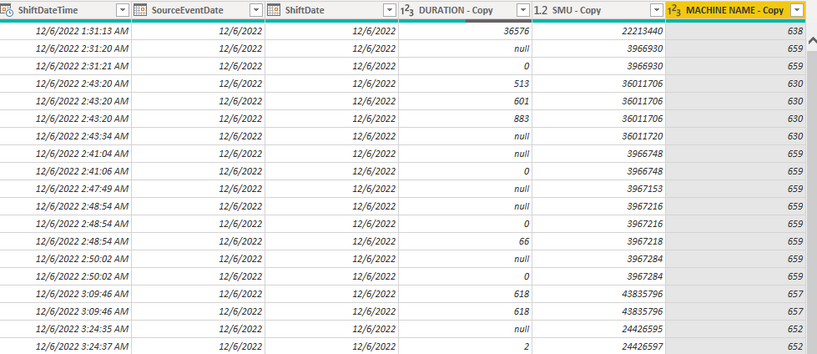- Power BI forums
- Updates
- News & Announcements
- Get Help with Power BI
- Desktop
- Service
- Report Server
- Power Query
- Mobile Apps
- Developer
- DAX Commands and Tips
- Custom Visuals Development Discussion
- Health and Life Sciences
- Power BI Spanish forums
- Translated Spanish Desktop
- Power Platform Integration - Better Together!
- Power Platform Integrations (Read-only)
- Power Platform and Dynamics 365 Integrations (Read-only)
- Training and Consulting
- Instructor Led Training
- Dashboard in a Day for Women, by Women
- Galleries
- Community Connections & How-To Videos
- COVID-19 Data Stories Gallery
- Themes Gallery
- Data Stories Gallery
- R Script Showcase
- Webinars and Video Gallery
- Quick Measures Gallery
- 2021 MSBizAppsSummit Gallery
- 2020 MSBizAppsSummit Gallery
- 2019 MSBizAppsSummit Gallery
- Events
- Ideas
- Custom Visuals Ideas
- Issues
- Issues
- Events
- Upcoming Events
- Community Blog
- Power BI Community Blog
- Custom Visuals Community Blog
- Community Support
- Community Accounts & Registration
- Using the Community
- Community Feedback
Register now to learn Fabric in free live sessions led by the best Microsoft experts. From Apr 16 to May 9, in English and Spanish.
- Power BI forums
- Forums
- Get Help with Power BI
- Desktop
- Subtracting a column value on one date from the pr...
- Subscribe to RSS Feed
- Mark Topic as New
- Mark Topic as Read
- Float this Topic for Current User
- Bookmark
- Subscribe
- Printer Friendly Page
- Mark as New
- Bookmark
- Subscribe
- Mute
- Subscribe to RSS Feed
- Permalink
- Report Inappropriate Content
Subtracting a column value on one date from the previous data date for a specific device
HI
I Have a problem I am trying to figure out.
I am fairly new to Power BI.
I want to add a column that takes the value of the SMU for a machine name and calculates the difference between it and the last value recieved.
So in the end a column that adds a value for SMU that would be just 1 days worth
Solved! Go to Solution.
- Mark as New
- Bookmark
- Subscribe
- Mute
- Subscribe to RSS Feed
- Permalink
- Report Inappropriate Content
@bmacman , a new column
new column =
var _max = maxx(filter(Table, [Machine name] = earlier([Machine name]) && [ShiftDateTime] < earlier([ShiftDateTime] ) ),[ShiftDateTime] )
return
[SMU] - maxx(filter(Table, [Machine name] = earlier([Machine name]) && [ShiftDateTime] =_max ),[SMU] )
Power BI DAX- Earlier, I should have known Earlier: https://youtu.be/CVW6YwvHHi8
Microsoft Power BI Learning Resources, 2023 !!
Learn Power BI - Full Course with Dec-2022, with Window, Index, Offset, 100+ Topics !!
Did I answer your question? Mark my post as a solution! Appreciate your Kudos !! Proud to be a Super User! !!
- Mark as New
- Bookmark
- Subscribe
- Mute
- Subscribe to RSS Feed
- Permalink
- Report Inappropriate Content
This works great. but how can I calculate the difference between dates in the above example.
The first date should show 0
- Mark as New
- Bookmark
- Subscribe
- Mute
- Subscribe to RSS Feed
- Permalink
- Report Inappropriate Content
Hi , @bmacman
According to your description, you want to calculate the "Subtracting a column value on one date from the previous data date for a specific device". Right?
Here are the steps you can refer to :
(1)This is my test data:
(2)We can click "New Column" and enter:
Column = var _machine = [MACHINENAME]
var _date = [Date]
var _previous_date =MAXX( FILTER('Table', 'Table'[Date]<_date && 'Table'[MACHINENAME]=_machine) ,[Date])
var _pre_sum = SUMX( FILTER('Table','Table'[Date] = _previous_date) , [SUM])
return
[SUM]-_pre_sum(3)Then we can get the data like this:
If this method does not meet your needs, you can provide us with your special sample data and the desired output sample data in the form of tables, so that we can better help you solve the problem.
Thank you for your time and sharing, and thank you for your support and understanding of PowerBI!
Best Regards,
Aniya Zhang
If this post helps, then please consider Accept it as the solution to help the other members find it more quickly
- Mark as New
- Bookmark
- Subscribe
- Mute
- Subscribe to RSS Feed
- Permalink
- Report Inappropriate Content
@bmacman , a new column
new column =
var _max = maxx(filter(Table, [Machine name] = earlier([Machine name]) && [ShiftDateTime] < earlier([ShiftDateTime] ) ),[ShiftDateTime] )
return
[SMU] - maxx(filter(Table, [Machine name] = earlier([Machine name]) && [ShiftDateTime] =_max ),[SMU] )
Power BI DAX- Earlier, I should have known Earlier: https://youtu.be/CVW6YwvHHi8
Microsoft Power BI Learning Resources, 2023 !!
Learn Power BI - Full Course with Dec-2022, with Window, Index, Offset, 100+ Topics !!
Did I answer your question? Mark my post as a solution! Appreciate your Kudos !! Proud to be a Super User! !!
- Mark as New
- Bookmark
- Subscribe
- Mute
- Subscribe to RSS Feed
- Permalink
- Report Inappropriate Content
Thanks that worked. Much aprreciated.
Helpful resources

Microsoft Fabric Learn Together
Covering the world! 9:00-10:30 AM Sydney, 4:00-5:30 PM CET (Paris/Berlin), 7:00-8:30 PM Mexico City

Power BI Monthly Update - April 2024
Check out the April 2024 Power BI update to learn about new features.

| User | Count |
|---|---|
| 107 | |
| 105 | |
| 79 | |
| 71 | |
| 66 |
| User | Count |
|---|---|
| 141 | |
| 107 | |
| 100 | |
| 82 | |
| 74 |



